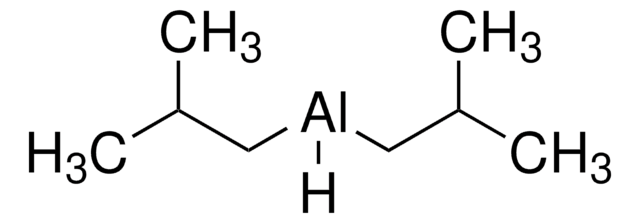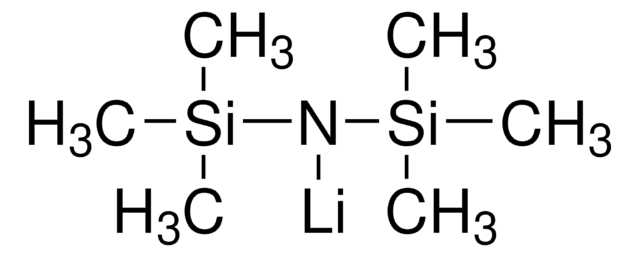214949
Diisobutylaluminum hydride solution
1.0 M in cyclohexane
Synonym(s):
DIBAL, DIBAL-H
Sign Into View Organizational & Contract Pricing
All Photos(1)
About This Item
Linear Formula:
[(CH3)2CHCH2]2AlH
CAS Number:
Molecular Weight:
142.22
Beilstein:
4123663
MDL number:
UNSPSC Code:
12352001
eCl@ss:
38120609
PubChem Substance ID:
NACRES:
NA.22
Recommended Products
form
liquid
Quality Level
reaction suitability
reagent type: reductant
concentration
1.0 M in cyclohexane
density
0.781 g/mL at 25 °C
SMILES string
CC(C)C[AlH]CC(C)C
InChI
1S/2C4H9.Al.H/c2*1-4(2)3;;/h2*4H,1H2,2-3H3;;
InChI key
AZWXAPCAJCYGIA-UHFFFAOYSA-N
Looking for similar products? Visit Product Comparison Guide
Application
Diisobutylaluminum hydride solution (DIBAL-H) can be used as a reducing agent in the:
- Hydrogenation of ester modified hydroxyl-terminated polybutadiene (HTPB) using cobalt catalyst.
- Synthesis of primary 6-OH alcohols by regioselective ring opening of 4,6-benzylidene acetals of hexopyranosides using triphenylcarbenium tetrafluoroborate as a catalyst.
- Conversion of an ester to alcohol.
Used in Pd-catalyzed reductive debromination of secondary alkyl bromides. O-Debenzylation and ring opening of perbenzylated furanosides. Convenient in situ generation of HZrCp2Cl from ZrCp2Cl2 and DIBAL-H.
WGK
WGK 3
Flash Point(F)
1.4 °F - closed cup
Flash Point(C)
-17 °C - closed cup
Personal Protective Equipment
dust mask type N95 (US), Eyeshields, Gloves
Choose from one of the most recent versions:
Already Own This Product?
Find documentation for the products that you have recently purchased in the Document Library.
Customers Also Viewed
Determination of the hydrogenation degree of telechelic polybutadiene by 1HNMR
Lira CH, et al.
Magnetic Resonance in Chemistry, 5, 22-22 (2006)
Triphenylcarbenium Tetrafluoroborate as an Efficient Catalyst in the Regioselective Reductive Ring Opening of Benzylidene Acetals of Carbohydrates
Thota N, et al.
ChemistrySelect, 4(27), 7976-7980 (2019)
Synthesis and transannular Diels-Alder reaction of a cis-trans-trans and a trans-cis-cis 13-membered macrocyclic trienone
Marinier A, et al.
Canadian Journal of Chemistry, 67(10), 1609-1617 (1989)
Damien Webb et al.
Organic letters, 14(2), 568-571 (2011-12-31)
A continuous flow system for the multiparameter (flow rate, temperature, residence time, stoichiometry) optimization of the DIBALH reduction of esters to aldehydes is described. Incorporating an in-line quench (MeOH), these transformations are generally complete in fewer than 60 s. Mixing
Hidetsura Cho et al.
The Journal of organic chemistry, 75(3), 627-636 (2009-12-31)
A systematic investigation of the reductive ring-expansion reaction of cyclic ketoximes fused to aromatic rings with diisobutylaluminum hydride (DIBALH) is described. This reaction regioselectively afforded a variety of five- to eight-membered bicyclic heterocycles or tricyclic heterocycles containing nitrogen neighboring an
Our team of scientists has experience in all areas of research including Life Science, Material Science, Chemical Synthesis, Chromatography, Analytical and many others.
Contact Technical Service






